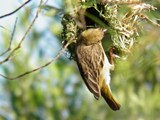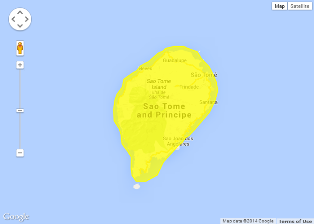Weaver species
Choose different species from drop-down list and press 'Go' button. See Full species list.Giant Weaver Ploceus grandis
IUCN: Least concern Discovery: 045Categories: island, blue eggs,
News items about species
Discovery
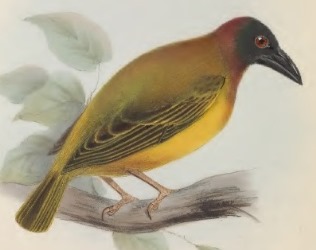
figure from Fraser 1849 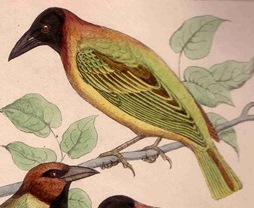
different races figure from Reichenbach 1863 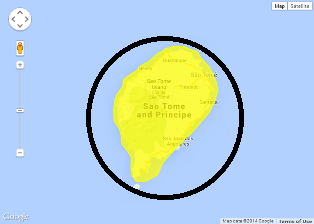
distribution, type locality circled IntroductionThe Giant Weaver was formally named by George Robert Gray, an English zoologist and author.The Giant Weaver was collected by Louis Fraser, a British zoologist and collector. Fraser participated in the British Royal Naval Expedition to the Niger River in 1841-42 as one of five civilian scientists appointed to the expedition. Fraser became ill on board and was considered too unfit to continue with the expedition when it returned to the West African mainland in March 1842. He made his own way to Bioko, reaching it by 15 May 1842, after spending six weeks along the Gulf of Guinea in other naval vessels. He began a collection of birds, mammals, fish and crustaceans. The months spent in the Gulf of Guinea from March to July were profitable (Moore 2001), and he collected the Giant Weaver on St Tome Island. In 1847, the British Museum purchased 64 bird skins from Fraser, including the Giant Weaver. Fraser published descriptions of some of his new birds in 1842, but named his weaver as Ploceus collaris. This name had already been used by Vieillot for a subspecies of the Village Weaver and was thus not a valid naming. Gray realised this and provided a new name in his list of genera and species in 1844. The first illustration of a Giant Weaver is a colour painting in Fraser 1849. The next illustration is by Reichenbach (1863), also of an adult male. Scientific citationHyphantornis grandis Gray 1844 Gen. Birds, 2, p.[1] of Ploceinae = Ploceus collaris Fraser nec Vieillot (1842, PZSL, p.142); Sao Tome.Meaning of namesgrandis - Latin: large, great.First English nameSt. Thomas' Weaver Bird (Fraser 1849).Alternate namesSt. Thomas' Weaver Bird, The great Weawer.CollectorLouis Fraser.Date collected1842, between March to July.Locality collectedSt. Tome Island.Type specimensOne specimen is known to be in the British Museum (BM 1847.1.18.3) together with 3 more syntypes (Warren 1971). |
The above is based on Weaver Wednesday 2, a weekly series about the discovery of each weaver species.
This species text first appeared as
Weaver Wednesday [162] - Discovery [45]: Giant Weaver on 2015-07-22
1. Basic biology
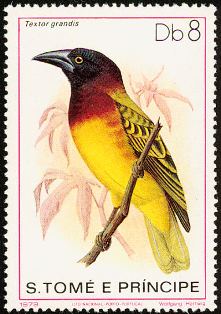
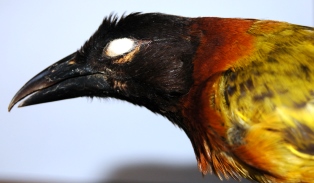
Identification. The Giant Weaver Ploceus grandis is a large weaver, the male's bill being larger than that of any other weaver. The male has a black head surrounded by chestnut, and resembles the Village Weaver, but the Giant Weaver has a pale eye (rather than red) and plain back (rather than streaked). The female Giant Weaver is dull coloured, and differs from the Village Weaver in having a pale eye, no supercilium, and buff breast (not yellow). In flight the Giant Weaver appears short and broad-winged. Distribution. The Giant Weaver is restricted to Sao Tome (see map below, based on Handbook of the Birds of the World, Vol. 15). No subspecies of the Giant Weaver are recognised. A century ago it occurred on Ilheu das Rolas, a small island south of Sao Tome, but is now extinct there.
Habitat. The Giant Weaver inhabits natural forest, plantations (coffee, oil palm, coconut, bamboo, cocoa), and clumps of woodland. It is rare in savanna, and common in degraded habitats, especially in the lowlands. Food. The Giant Weaver feeds on grass seeds, crushed nuts of cocoa trees, fruit, and berries. It also feeds on insects like beetles, and even snails have been recorded. The Giant Weaver feeds at all levels in vegetation, and sometimes on the ground. It forages singly, in pairs and in small parties, but does not join mixed-species flocks. Breeding. The Giant Weaver is a monogamous, highly territorial, solitary nester. The male may beat his wings in perched display near the nest. The nest is a large untidy ball with no entrance tunnel. It is built with strips of palm leaves, and is supported below branches and well hidden. The nest is placed in palm or other tall trees. The clutch is 1-2 eggs, which are plain blue. Nothing else is known about its breeding cycle. |
The above is based on Weaver Wednesday, a weekly series about weaver species.
This species text first appeared as
Weaver Wednesday [86]: Giant Weaver on 2014-02-04
2. Breeding facts
| Pair bond Monogamous Breeding season Egg-laying observed in Jan, copulation and nest-building noted in Dec, and juveniles in Mar-Apr Nest site supported from below by branches Nest building No information Colony size Solitary nester; highly territorial if conspecifics in same area Clutch size 1-2 eggs Egg colour plain blue Egg size No information Incubation No information Chicks and nestling period No information |
Breeding information based on Handbook of the Birds of the World, Vol. 15.
3. Photos of Weaver Nests
No records yet - be the first to submit a PHOWN record!See PHOWN summary page for this species here.
PHOWN (Photos of Weaver Nests) provides valuable info on breeding distribution and colony sizes of weavers.
You can contribute by registering and submitting photos at Virtual Museum webpage.
4. Breeding distribution
Google map showing distribution (For species with small ranges you need to zoom in at the correct area to see the range):
yellow blob - range of weaver species; read more about this here.
![]() - PHOWN records with photos
- PHOWN records with photos
![]() - PHOWN records with no photos (Nest Record Cards, other records)
- PHOWN records with no photos (Nest Record Cards, other records)
![]() - Birdpix records
- Birdpix records
![]() - comments on out of range records, or interesting records
- comments on out of range records, or interesting records
![]() - type locality
- type locality
CLICK on the marker on the map to see individual record details.
5. Range changes
Not South African speciesThe above is based on Weaver Wednesday 3, a weekly series about range changes in South African weaver species.
This species text first appeared as
n/a








